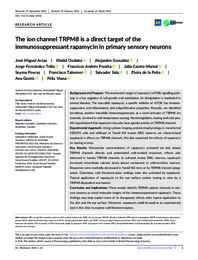Título :
The ion channel TRPM8 is a direct target of the immunosuppressant rapamycin in primary sensory neurons |
Autor :
Arcas, José Miguel
OUDAHA, KHALID
González, Alejandro
Fernández-Trillo, Jorge
Peralta, Francisco Andrés
Castro-Marsal, Júlia
Poyraz, Seyma
Taberner, Francisco
Sala, Salvador
De la Peña García, Elvira 
Gómis, Ana
Viana, Félix |
Editor :
WILEY |
Departamento:
Instituto de Neurociencias |
Fecha de publicación:
2024 |
URI :
https://hdl.handle.net/11000/32391 |
Resumen :
Background and purpose: The mechanistic target of rapamycin (mTOR) signalling pathway is a key regulator of cell growth and metabolism. Its deregulation is implicated in several diseases. The macrolide rapamycin, a specific inhibitor of mTOR, has immunosuppressive, anti-inflammatory and antiproliferative properties. Recently, we identified tacrolimus, another macrolide immunosuppressant, as a novel activator of TRPM8 ion channels, involved in cold temperature sensing, thermoregulation, tearing and cold pain. We hypothesized that rapamycin may also have agonist activity on TRPM8 channels.
Experimental approach: Using calcium imaging and electrophysiology in transfected HEK293 cells and wildtype or Trpm8 KO mouse DRG neurons, we characterized rapamycin's effects on TRPM8 channels. We also examined the effects of rapamycin on tearing in mice.
Key results: Micromolar concentrations of rapamycin activated rat and mouse TRPM8 channels directly and potentiated cold-evoked responses, effects also observed in human TRPM8 channels. In cultured mouse DRG neurons, rapamycin increased intracellular calcium levels almost exclusively in cold-sensitive neurons. Responses were markedly decreased in Trpm8 KO mice or by TRPM8 channel antagonists. Cutaneous cold thermoreceptor endings were also activated by rapamycin. Topical application of rapamycin to the eye surface evokes tearing in mice by a TRPM8-dependent mechanism.
Conclusion and implications: These results identify TRPM8 cationic channels in sensory neurons as novel molecular targets of the immunosuppressant rapamycin. These findings may help explain some of its therapeutic effects after topical application to the skin and the eye surface. Moreover, rapamycin could be used as an experimental tool in the clinic to explore cold thermoreceptors.
|
Palabras clave/Materias:
ageing
cold
dry eye disease
mTOR
pain
thermoregulation |
Área de conocimiento :
CDU: Ciencias aplicadas: Medicina |
Tipo de documento :
info:eu-repo/semantics/article |
Derechos de acceso:
info:eu-repo/semantics/openAccess |
DOI :
https://doi.org/10.1111/bph.16402 |
Publicado en:
British Journal of Pharmacology, 2024 May 13 |
Aparece en las colecciones:
Instituto de Neurociencias
|
 La licencia se describe como: Atribución-NonComercial-NoDerivada 4.0 Internacional.
La licencia se describe como: Atribución-NonComercial-NoDerivada 4.0 Internacional.
.png)
